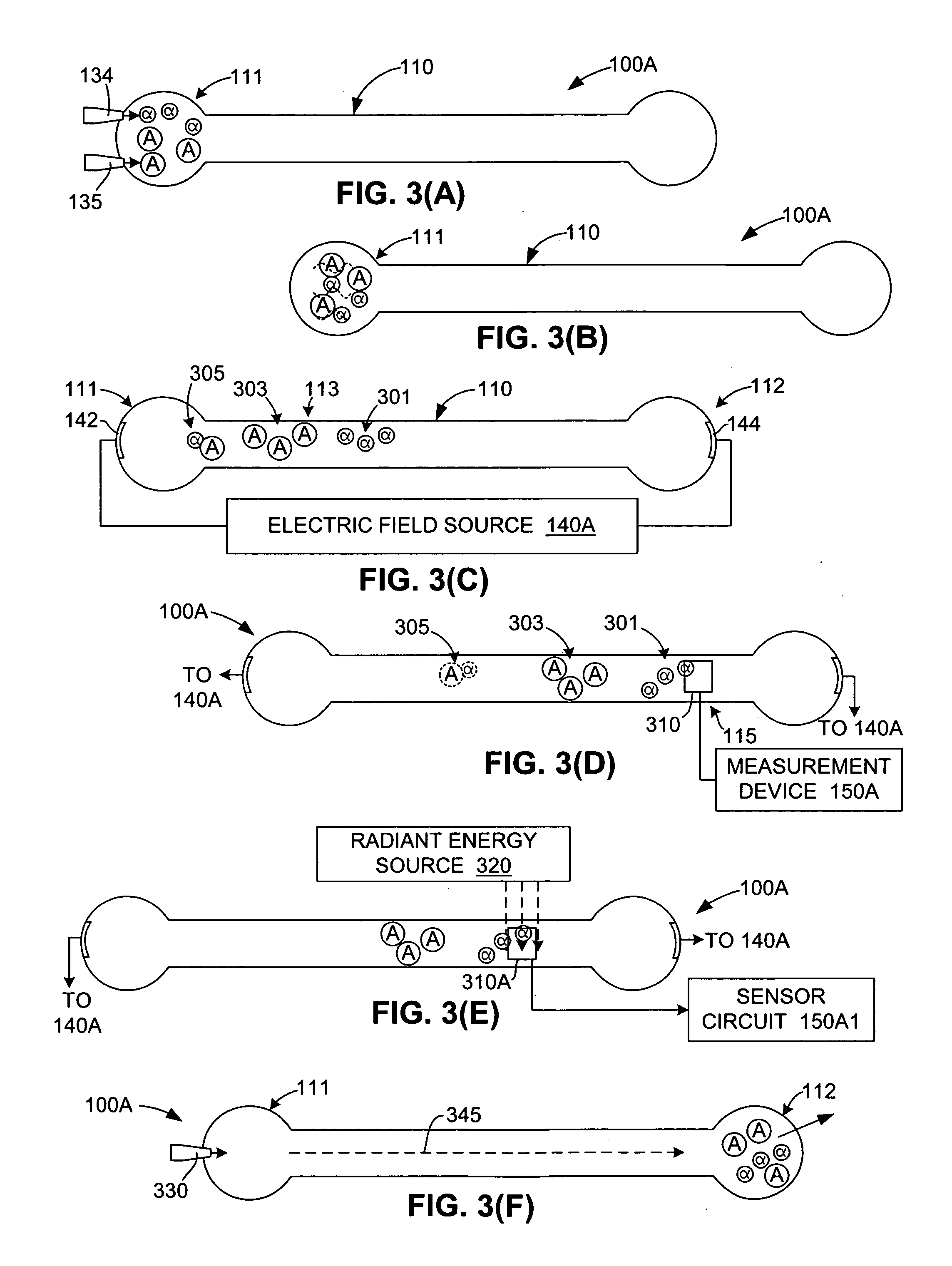[0005] The present invention is directed to a method and apparatus for detecting binding events between two or more molecules (e.g., a ligand and a protein) that includes mixing the molecules at a first location in a test channel, separating the bound/unbound molecules (e.g., using electrophoresis) such that groups of bound and unbound molecules move along the channel at different rates, detecting and measuring the size of the bound/unbound molecule groups, and then comparing the measurement values against established reference data to determine whether a binding event has occurred. Mixing involves, for example, injecting sub-nanoliter-sized doses of a selected ligand and a selected protein into a receptor well located at a first end of the test channel, and activating a suitable mixing mechanism. Separating involves, for example, applying a suitable motive force (e.g., an electric field) that causes the bound and unbound molecules to separate into three possible groups that move along the channel at different rates: the smaller unbound ligands may, for example, form a first (fastest) group in the channel, followed by the larger unbound proteins, and then the bound ligand/protein pairs. The actual magnitudes and sign of dispersed molecular velocities depends on the particular channel structure, channel filling (e.g. particle packing, gel, empty, etc.), motive mechanism, molecular properties (e.g. charge, mass, size, state of naturation, etc.) Detection and measurement of the size of each group (i.e., an estimate of the number of molecules in each group) is performed using a stationary detector (e.g., a bolometer) that is positioned at a second location along the test channel. Finally, these measurements are then compared with reference data to determine whether a binding event has occurred, and can be used to estimate the relative strength of the binding event. For example, in one embodiment, the detection of two relatively large groups passing the detector may be interpreted as groups of unbound ligands and unbound proteins, thereby indicating a non-binding event. In contrast, two smaller groups followed by a larger group, or a single large group may be interpreted to indicate moderate to strong binding between the proteins and ligands. Accordingly, the present invention provides a generic and inexpensive method for detecting molecular binding events.
[0006] According to an embodiment of the present invention, photothermal detection is utilized to measure extremely small (e.g., sub-nanoliter) doses of the bound/unbound molecular groups moving in the test channel. In one embodiment, a radiant energy source is transmitted into the test channel at a wavelength that is absorbed by the moving molecules, but is not significantly absorbed by the channel liquid (e.g., water) in which the molecules are suspended. To further enhance optical absorption by the molecules, the radiant energy is repeatedly passed through the channel using a reflecting device (e.g., an etalon). The optically absorbed energy is converted to heat by the molecules and dissipated in the liquid. A highly sensitive thermometer (e.g., a bolometer) is positioned in the channel and utilized to generate temperature profiles indicating local heating of the channel liquid as the groups of bound and unbound molecules pass through. The temperature profiles are then analyzed (e.g., compared with reference data) to determine whether a binding event has taken place. Accordingly, the present invention facilitates binding event detection using very small (e.g., sub-nanoliter) molecule doses.
[0007] According to another embodiment, an apparatus for detecting binding events utilizes both a test (first) channel and a reference (second) channel or channels that are substantiall
 Login to View More
Login to View More  Login to View More
Login to View More 


